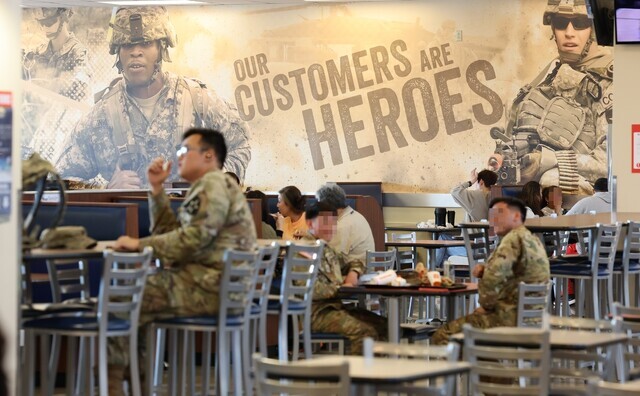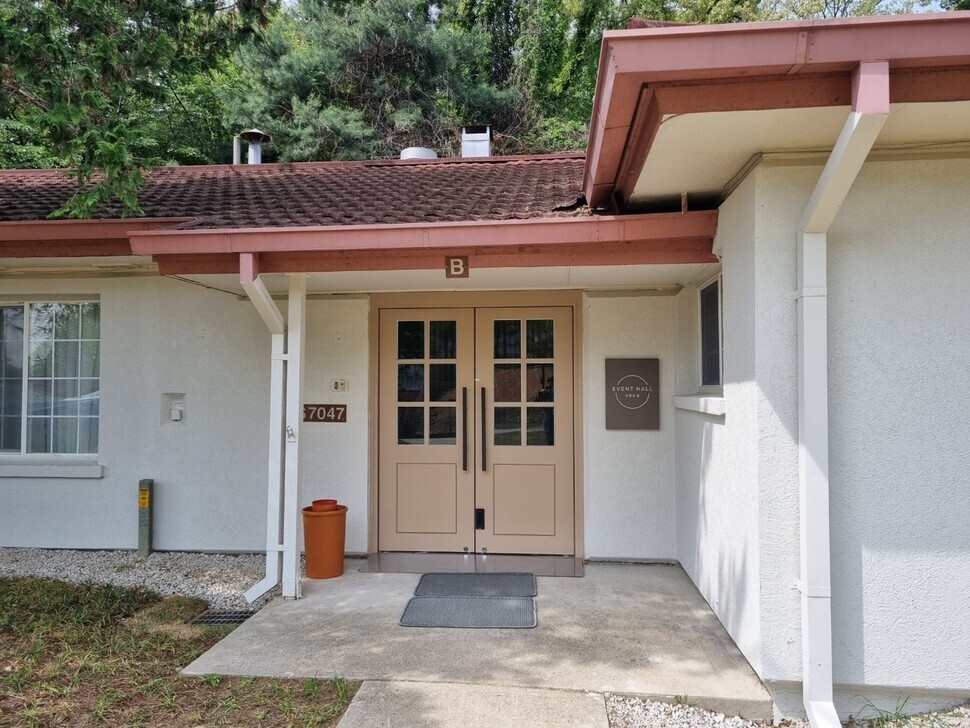hankyoreh
Links to other country sites 다른 나라 사이트 링크
Camp Humphreys: A sprawling symbol of the SK-US alliance where war and life blur

Editor’s note: This year marks the 70th anniversary of the Armistice Agreement that halted the fire of the Korean War (July 27) and of the South Korea-US Mutual Defense Treaty (Oct. 1).
To get a sense of where the South Korea-US alliance stands 70 years on, we visited two of its symbolic sites: Camp Humphreys, which is a US Army garrison in Pyeongtaek, Gyeonggi Province, and Yongsan, an area of Seoul where the troops had previously been stationed.
“Apart from having to take a bus to get food after training, I’m satisfied with my life in the military.”
Ryu Ho-jeon’s voice was punctuated with small wheezes after a workout at the gym when I met him on May 9. The 20-year-old is an enlisted South Korean augmented to the United States Army, a program known as “KATUSA,” based at Camp Humphreys US military base in Pyeongtaek, a city in Gyeonggi Province, South Korea.
Camp Humphreys is so vast that, as Ryu put it, it’s impossible to get around without taking a bus. The military base covers an area of 14.67 square kilometers (5 square miles) — five times the size of Yeouido — and ordinarily accommodates up to 43,000 US military personnel and their families.
The US military base turned over my expectations of what I thought an ordinary military base would look like—when I entered, I saw storefronts, shopping malls, hair salons, nail salons, schools, a library, and hospitals. Even the road signs were in miles, not kilometers.
It was early afternoon on a weekday, but on the lawn next to the gymnasium, about 10 soldiers and their families were grilling meat or playing catch. Accommodation facilities are divided according to rank (soldiers and officers), but everyone has access to a well-looked-after apartment.
It feels very much like an American city. Under the Status of Forces Agreement, US law, not Korean, applies here, and the US forces stationed in Korea are recognized as having de facto extraterritorial authority even outside the base.
As of now, Camp Humphreys is the US military’s largest overseas base. Home to the United Nations Command, US Forces Korea, US Special Operations Command, Eighth US Army, and the 2nd Infantry Division Headquarters, it is a key base for US forces in Korea and a symbol of the South Korea-US alliance established on Oct. 1, 1953, with the signing of the South Korea-US Mutual Defense Treaty.
Camp Humphreys, one of several US military bases in South Korea, grew in size in 2004 when South Korea and the United States signed the Yongsan Relocation Plan and the South Korea-US Land Partnership Plan to move the US divisions in Uijeongbu and Dongducheon to Pyeongtaek.

This signaled an end to the “Yongsan era” of the US Forces Korea and marked the beginning of the “Pyeongtaek era,” as US military bases across the country were consolidated into Camp Humphreys. Camp Humphreys is the closest US military base to China, and together with Pyeongtaek Port and Osan US Air Base in Pyeongtaek, it serves as the US military’s military hub in Northeast Asia to deter China.
“At the request of the South Korean government, we moved a large number of US troops to Pyeongtaek to consolidate, which required Humphreys to grow by more than 2,000 acres and triple in size,” Garrison commander Col. Seth Graves told the Hankyoreh. “With the relocation of US Forces Korea last year, we are in the final stages of planning for the relocation from Yongsan, which began in 2004.”
The sprawling Camp Humphreys site was also built on the suffering of residents of Daechuri, a small village in Gyeonggi Province. The expansion of Camp Humphreys to an area of 10 square kilometers northwest of the existing site was strongly resisted by the village’s residents, who were forced to leave their homes.
On May 4, 2006, police stormed Daechuri Elementary School, where residents were gathered, injuring 210 people and detaining 524.
As I walked back from my interview, Apache attack helicopters were taking off and landing on the tarmac of the air base here. Across the tarmac from the soldiers’ quarters and the playground, children played, a strange mix of weaponry and everyday life. With 28,500 troops and advanced weaponry, I felt that the power of the US Forces Korea in key locations should be used for peace on the Korean Peninsula.
The US military has relocated to Pyeongtaek, putting Yongsan back in South Korean hands for the first time in 120 years. To date, the US military has returned 634,000 square meters of the Yongsan base site, about 30 percent of the total 2.43 million square meters, and the Foreign Ministry and Defense Ministry are negotiating with the US about the return of the rest of the site.
The Yongsan base, which has been home to the Japanese military since 1904 and the US military since liberation in 1945, will be transformed into a national park, and only buildings with high historical value will be left on the site.
The Yongsan Children’s Garden, which is part of the national park, opened on May 4. On Wednesday, when I entered the children’s garden through the main entrance, which used to be Gate 14 of USFK’s Camp Casey, I saw a row of red-roofed buildings that used to house US military generals.
As I passed by the buildings, I saw a large grassy field that used to be used by US soldiers as a baseball field. Beyond the grassy field, an elementary school baseball team was preparing for a tournament. It was so peaceful that it was hard to believe that it was a US military base not long ago.
However, there are concerns that the children’s garden was opened too soon after the environmental cleanup of Yongsan base. It is believed that the soil was contaminated due to frequent oil spills during its use as a US military base, but the area was opened without proper purification of the land.
Environmental groups have also raised concerns about possible carcinogenic contamination. While the government says there are “no safety concerns,” environmentalists worry that this could set a precedent for South Korea to foot the bill for the costly cleanup of US military bases.
Throughout the Japanese occupation and division of Korea, the Yongsan US military base became a symbol of Korea’s modern history. If Yongsan National Park is to be cleansed of the stains of history and fully returned to the public, it will take a long, long time and will have to involve many discussions with Korean civil society.
By Shin Hyeong-cheol, staff reporter
Please direct questions or comments to [english@hani.co.kr]

Editorial・opinion
![[Editorial] Penalties for airing allegations against Korea’s first lady endanger free press [Editorial] Penalties for airing allegations against Korea’s first lady endanger free press](https://flexible.img.hani.co.kr/flexible/normal/500/300/imgdb/original/2024/0502/1817146398095106.jpg) [Editorial] Penalties for airing allegations against Korea’s first lady endanger free press
[Editorial] Penalties for airing allegations against Korea’s first lady endanger free press![[Editorial] Yoon must halt procurement of SM-3 interceptor missiles [Editorial] Yoon must halt procurement of SM-3 interceptor missiles](https://flexible.img.hani.co.kr/flexible/normal/500/300/imgdb/child/2024/0501/17145495551605_1717145495195344.jpg) [Editorial] Yoon must halt procurement of SM-3 interceptor missiles
[Editorial] Yoon must halt procurement of SM-3 interceptor missiles- [Guest essay] Maybe Korea’s rapid population decline is an opportunity, not a crisis
- [Column] Can Yoon steer diplomacy with Russia, China back on track?
- [Column] Season 2 of special prosecutor probe may be coming to Korea soon
- [Column] Park Geun-hye déjà vu in Yoon Suk-yeol
- [Editorial] New weight of N. Korea’s nuclear threats makes dialogue all the more urgent
- [Guest essay] The real reason Korea’s new right wants to dub Rhee a founding father
- [Column] ‘Choson’: Is it time we start referring to N. Korea in its own terms?
- [Editorial] Japan’s rewriting of history with Korea has gone too far
Most viewed articles
- 160% of young Koreans see no need to have kids after marriage
- 2Months and months of overdue wages are pushing migrant workers in Korea into debt
- 3[Editorial] Penalties for airing allegations against Korea’s first lady endanger free press
- 4Historic court ruling recognizes Korean state culpability for massacre in Vietnam
- 5Presidential office warns of veto in response to opposition passing special counsel probe act
- 6[Guest essay] How Korea must answer for its crimes in Vietnam
- 7Story of massacre victim’s court victory could open minds of Vietnamese to Korea, says documentarian
- 8Historic verdict on Korean culpability for Vietnam War massacres now available in English, Vietnames
- 9Bills for Itaewon crush inquiry, special counsel probe into Marine’s death pass National Assembly
- 10In rejecting statute of limitations defense in massacre case, Korean court faces up to Vietnam War a